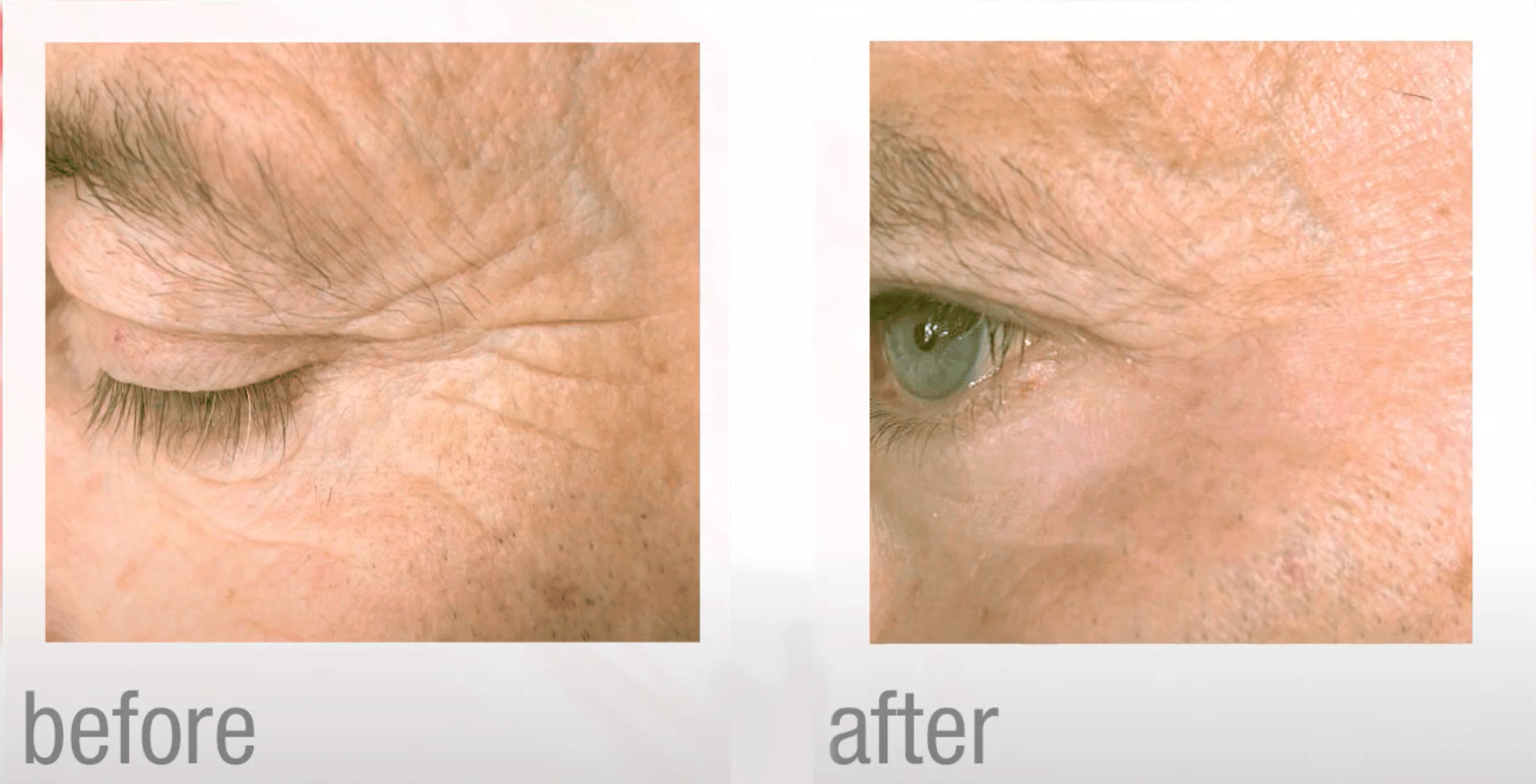Erbium Laser Ablative
Skin Resurfacing
Turn back the clock and peel off the signs of time to reveal a more youthful look.
SUMMARY
The Erbium laser skin resurfacing is a nonsurgical procedure that significantly improves skin tone, texture, and other imperfections, greatly reduces wrinkles, and removes nearly all fine lines. The laser heats up the deeper layers of the epidermis, or the superficial skin, and causes microscopic injuries to the skin. The body’s healing response is triggered, and while healing, it gives an effect comparable to sanding wooden floors to make them look brand new.
WHERE
Physimed MediSpa, Montreal
ANESTHESIA
Local topical anesthetic
PAIN
Low-mid
LENGTH OF PROCEDURE
30-60 minutes
RECOVERY TIME
3-10 days depending on depth
before & after gallery
Click here to view this before and after
INVASIVENESS
Low-mid
Laser skin resurfacing involves heating up the deeper layers of the epidermis, or the superficial skin, which causes microscopic damage to the skin. Also, it gently vaporizes the surface layers of the skin to reveal the fresh, new skin beneath. Thus, the body’s healing response to regenerate and repair the skin is triggered. During this process, the skin’s tone, texture, and imperfections improve dramatically. The healing response stimulates collagen production in the dermis.
The treatment is very effective in treating wrinkles, acne scars, dark spots and freckles, dark circles, crepey skin, dullness, and discolouration. It also provides some mild tightening to the skin.
The Erbium laser beam gently vaporizes micron-thin layers of the epidermis while thermally affecting deeper skin layers to stimulate the production of new collagen in the dermis.
Laser resurfacing treatments can be divided into two categories: ablative and non-ablative.
- Ablative laser treatments, like our ablative Fotona Erbium laser, vaporize the surface layers of your skin while simultaneously heating the water molecules in the deeper layers, which triggers the healing response. The recovery varies with the depth of treatment chosen, but the skin removal generally leaves your skin red and raw, and recovery lasts quite a few days.
- Non-ablative laser treatments, like our non-ablative Fotona Erbium laser, heat the deep layer of the skin but leave the surface of the skin intact. There’s little to no significant downtime after these procedures.
Which type of laser treatment is the one for you?
Ablative lasers give dramatic results in a single session, but the recovery is long. Non-ablative lasers give great results, but they aren’t as significant or noticeable. To achieve optimal results, multiple sessions are required. However, there is minimal to no downtime.
For deep furrows, sun damage, and sagging, crepey skin, ablative lasers will be much more effective.
Note that fractional lasers can be both ablative and non-ablative, but target only a portion of the skin and thus result in less downtime.

The number of treatments required depends on the depth of ablation, but one ablative laser resurfacing treatment alone can give tremendous results. Patients report a reduction in fine lines and wrinkles, even tone, smoother texture, softer skin, reduced scars, and firm skin.
The results of the treatment will appear after the peeling has subsided and some of the redness has faded after the treatment. Typically, this happens after 10 to 14 days. However, it may take three to six months to see the fullest results, since new collagen is being produced.
This procedure can be thought of as finishing wooden floors. If you want a dramatic change to your floors, so that they appear new and have a nice glow and finish, you can sand your floors. Buffing them will improve them as well, but not to the same extent. Resurfacing skin with a fully ablative laser is equivalent to sanding the wooden floors.
Non-ablative laser resurfacing results are more gradual and subtle. They only appear over the course of several months. However, after a series of multiple treatments, you will see significant improvements in your skin tone and texture.
Ablative and non-ablative laser resurfacing treatments yield results that last 8 to 10 years. Nevertheless, as your skin is exposed to environmental factors like sunlight and as time passes and you age, your skin will be affected and continue to change.
If you are prone to cold sores, we will prescribe an antiviral medication to prevent an outbreak, as well as an antibiotic to limit the possibility of infection. We might also ask you to use a topical retinoid for a month pre-treatment, or ask you to have two microdermabrasion treatments in order to boost cell turnover. To avoid any pigmentation issues, please keep away from sun exposure two weeks before your treatment and one month after your treatment. A tan may cause complications.
During the procedure
We typically perform ablative laser resurfacing in the procedure room. You will be administered a local anaesthetic to numb the skin and make the treatment more comfortable and tolerable. The treatment takes 30-60 minutes, based on how large the area we treat is. Once the procedure is over, we apply a healing ointment and send you home with some to use for the first few days at home.
During the procedure, the ablative laser vaporizes the outer surface layer of skin and heats the inner layers. The laser triggers the skin’s repair process, collagen production, and the existing fibers to shrink. The shrunken collagen tightens and smooths skin from the inside.
After the procedure
For recovery, expect to require a few days off. The time your skin needs to heal depends on the depth of ablation – the deeper we go, the longer time is to be expected. Immediately after the procedure, your skin will be raw, swollen, itchy, and blistered. You will feel and look fairly sunburned. Your skin may even ooze for a few days, then crust up and peel.
Please try not to pick at or scratch your skin, or else you may cause some scars. To limit the swelling in your face, you can use ice packs and keep your head elevated by sleeping on an extra pillow.
While your skin is still very raw during the first couple of days, hygiene will be essential. You will need to cleanse your skin several times daily with a saline or vinegar solution, then moisturize it.
The peeling will subside in around a week. Once it does, you can start wearing oil-free makeup to hide the redness. Your skin may still stay slightly pink for several weeks, especially if you have a fair complexion. To protect your brand new skin, you must diligently use a broad-spectrum sunscreen (SPF 30 or higher) daily.
Anyone of a mature age or younger patients with significant damaged skin, like severe acne scars, can benefit from a fully ablative laser resurfacing to rejuvenate their skin. At Physimed MediSpa, we use the Fotona Erbium YAG fully ablative laser which can be used on all skin types. However, caution should be used on patients with darker skin complexion in order to avoid hyperpigmentation.
Fully ablative laser resurfacing is primarily used on the face.
Ablative laser resurfacing procedures call for five to seven days of downtime.
Non-ablative laser resurfacing treatments have limited downtime after. You might experience pinkness or mild swelling for a few hours up to a few days post-treatment, but no time off is required. You can return to your normal activities immediately afterwards. Nevertheless, it is important to note that it is necessary to go through a series of three to six non-ablative laser treatments to achieve the same result as one ablative laser treatment.
Laser resurfacing treatments may cause an outbreak of cold sores if you are prone to them. To prevent this, we will prescribe you an antiviral medication.
Laser resurfacing is a safe procedure. However, patients with dark complexions have a risk of developing hyperpigmentation from the treatment.
A procedure that pairs well with laser resurfacing is IPL (intense pulsed light) photo-rejuvenation treatments. IPL helps reduce sun damage, brown spots, and red spots that may develop due to the resurfacing.
We offer many nonsurgical and minimally or non-invasive treatments at Physimed Medispa. If you are looking to improve your skin texture and tone, please consider the procedures below.
Request a consultation or more information and begin your journey. The Difference is Beautiful.



